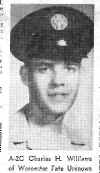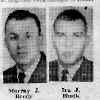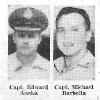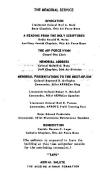from
Dean-Boys
Lockheed EC-121H Super Constellation 55-0136 (4409)
United States Air Force
(Lockheed RC-121D-LO Super Constellation converted to EC-121H.
Redesignated EC-121D in 1962.)
From the Record American July 13, 1965
Bay State Flier 1 of 3 Survivors
16 AF men dead, lost in the icy sea

Click for larger foto
By JOHN MoGINN, KEN POWERS
and FRANK McGRATH,
FALMOUTH
The doleful task of notifying the next of kin
that 16 of the 19 men who crashed in the Atlantic aboard an Air
Force picket plane are
either dead or missing at sea; was being carried out last night as
hope was all but abandoned for seven men still missing.
Accompanied by clergymen of three faiths, Otis Air Force Base
Commander Col. Raymond Gallagher visited the homes of the men on
thebase and in surrounding towns.
Telegrams officially notifying families not in the area also were
sent out. To only three families was Col. Gallagher able to give the
heartening news that their kin were safe and would soon be home.
AIR SEARCH ENDS
And out in the Atlantic, 100 miles northeast of
Nantucket,' zero visibility forced the cancellation of air search
for the seven still lost.
Nine surface vessels still combed the waters, but their chances of
finding anyone in the foggy night were slim.
On one the vessels, the West German destroyer Z-1 the three
survivors and the bodies of nine dead were transferred to the Aircraft Carrier Wasp despite he grim
weather. The survivors were being flown to Otis where they will be checked physically, and report to Gen. C. B. Johnson for a
debriefing session before rejoining their families
NEWS SHOCKING
The nine dead will be flown to Boston and taken to Chelsea Naval Hospital to be prepared for burial. Knowledge that there are only three survivors caused shock and disappointment because early reports from the crash scene had 10 saved and eight dead and one unaccounted for. However, at mid afternoon both Capt. Warren Mitchell, of the Coast Guard Search and Rescue unit at Boston, and Capt. Richard Barrows, public information officer at Otis Air Force Base, revised their figures for the worse.
CONTACTS POOR
Poor communications between the carrier Wasp which was at the scene of the crash and the Coast Guard headquarters in Boston was given as the reason for the early-- inaccurate-- figures. The news hit Otis Air Force Base, and the civilian community of Falmouth, hard. Earlier, there had been hope that most of the men had managed to survived the crash--through the flag Otis ad been lowered to half-staff in tribute to those who had died.
SEARCH CONTINUING
Then, while civilians, airmen and the families of the crewmen were
waiting for further word, there came the new report that only three of
the19 were known to be alive. "The search for those who are missing is
still continuing," Barrows told reporters.
Even before the late report, the Air Force had announced that a board of
inquiry had been appointed and was en route to Otis to open an
investigation into what caused the four-motored, triple-tailed plane to
crash into the sea. It was known that one motor had caught fire and
another had to be feathered and there was speculation that the aircraft
could have been s t r u c k by lightning during a storm at sea. But, at
first, the necessity to find the cause of the tragedy took a back seat
to the effort to rescue the men----and hopes that most would be saved
grew when, soon after dawn--despite a thick fog-rescue planes spotted
several of them, wearing life jackets, bobbing in the frigid water.The
Wasp, two West German destroyers, two American destroyers and four Coast
Guard cutters had been steaming at flank speed throughout the murky
night to reach the scene. At daybreak, helicopters took off from the
Wasp and despite an overcast that cut the visibility to less than 50
yards, ran ahead of her to the pinpoint in the ocean where the hump -
backed plane, loaded with men and radar gear, had gone down. It was soon
afterward that dye markers were seen on the ocean surface and, as
choppers and propeller-driven aircraft converged on the scene, the
figures in the water were spotted. The water temperature in the area was
between 53 and 58 degrees, cold enough to numb anyone trying to stay
afloat several hours, as the Crewman had to do. Then, as they were being
picked up, foul w Bather raised havoc with communications equipment,
resulting in the confusion that, for a few hours, caused the families
and buddies of the crewmen to cling to the hope that most would be
saved. The plane a member of the 551st Airborne and Early Warning Wing,
was part of an armada of about 38 such ships assigned to Otis Field as
part of the North American Air Defense system. Its loss and the loss of
part of its crew was I the first such tragedy to cut I the ranks of
NORAD men in the past 10 years.
List of 18 Men Aboard Plane
OTIS AFB --- Eighteen of the 19 men aboard the EC121H radar picket plane that ditched Sunday night in the Atlantic Ocean off Nantucket were identified by the Air Force Monday. The name of the 19th crewman,
identified only as a pilot, (Lt Fred Ambrosia Aircraft Commander) was withheld pending notification of next of kin. Named as aboard the plane were:
|
Capt.
Murray J. Brody, New York City, pilot . |
1st Lt. Thomas Fiedler, Davenport, Iowa, co-pilot. |
| Capt. Edward N. Aneka, an Air Force Reserve Officer Training Corp AFROTC instructor at Davis and Elkins College in Elkins, W. Va. |
Capt. Michael R. Barbolla, an AFROTC instructor at Manhattan College in New York City. |
| . TSgt. Eugene J. Schreivogel, Springfield, Col., flight engineer. |
T. Sgt. Gilbert T. Armstrong, Duncan, S. C., flight engineer. |
| S. Sgt. Francis Griffith,
Toronto, Canada, radio operator. |
S. Sgt. Raymond M. Washam, Wilmington, Del., radio operator |
| Airman 3.C Charles a. PodJacki,
Evergreen, Ill., radar technician. |
S. Sgt. ,John L. Howard Sanford. Fla., radar technician. |
| Airman 1.C George R. West, Grand Rapids, Mich., radar technician. |
Airman 1.C Charles K. Sawyer, Anderson, S. C., radar technician. |
| Airman 1.C John N. Puopolo, Roslindale, Mass., radar Operator. |
Airman 2.C Charles H. Williams, Worcester, Mass.,
radar technician. |
| Airman 2.C William E. Howe, North Augusta, S. C., radar technician. |
Airman 2.C David A. Surles, Raleigh. N. C., radar technician. |
(The Air Force said Capts Aneka and Barbolla were
not members of the plane's crew
but were on the flight as observers.)
Click for larger foto
Fliers Describe Icy, 10 Hour Ordeal
By AL SALIE and BILL DUNCLIFFE
OTIS AIR FORCE BASE
Two of the three survivors of an Air Force picket plane that was forced
to ditch in the Atlantic Sunday night told a press conference yesterday
how they shivered together for more than 10 death-shadowed hours and
never gave up hope that they would be saved. Airman 1/c John N Puopolo
25, of Sagamore and Roslindale. was the only, one of the three unable to
attend the briefing. Air Force Dr. Robert Weisberg said he had swallowed
a "considerable" amount of sea water during his ordeal and was so
afflicted with nausea that he had to be fed intravenously. However, his
fellow survivors, Lt. Bruce Witcher, 27, of Redding, Cal., navigator,
and Airman 2/c David Surles, 24, of Raleigh N. C.. spoke for him. "My
job was to open the life raft when the plane hit," Surles said, "The
aircraft broke up and I tried to get at the raft, but it was stored in
the wing, which was under water, and I couldn't get it. "Finally I got
out of the plane through a hole, and I swam away from it as fast as I
could, because it was sinking and I didn't want to be sucked down with
it when it sank. I began yelling and I heard a voice. It was Puopolo. I
swam over to him and we held on to each other for ten hours and 40
minutes, until we were rescued. "I never gave up hope at any time,"
Surles said, "but we were pretty numb when we were picked up. The men
aboard the German destroyer that saved us were just as wonderful as they
could be. Lt. Witcher said he did not get warmed up and couldn't talk
without his teeth chattering for four hours after he was picked up by a
German destroyer taking part in a NATO naval exercise. And, as the
interview began, the first of those who died in the crash was
identified--and the news brought heartbreak to a 21-year-old Lewiston,
Me. wife. Mrs. Dorothy West, of Wilson st, - Lewiston. was notified by
the Air Force that her husband, Airman George C. West 22, was one of
nine known dead among the plane's crew. Mrs. West, who is expecting her
first child in five weeks, said that while her husband had been in the
Air Force nearly four years, he had been on flying status for only three
months. West, in the first roster of the plane's crewmen to be issued by
the Air Force, was identified as coming from Grand Rapids, Mich. Mrs.
West is staying with her mother in Lewiston while awaiting the birth of
her child. Witcher said that after the Number Three engine caught fire
and it became apparent that they would have to ditch be took
navigational "fix' determined the plane's position.
ART KERR RECALLS TOM FIEDLER AND FRED AMBROSIA
On 11 July 1965, the 961st lost a Connie at sea off Nantucket Island. Lieutenants Fred Ambrosia and Tom Fiedler were the pilots. Tech Sergeants Gene Schreivogel and Gil Armstrong were the flight engineers. There was a full crew on board as well as some ROTC instructors who were at Otis for ROTC summer camp; they were getting some EC-121 mission familiarization. There were three survivors but most of the crew were lost, some bodies were recovered. Miscellaneous parts of the aircraft and crew equipment were picked up. Found Tom's flight jacket - had his keys in the pocket. Made it easy to get his car started - Jim Goodman drove Tom's car back to the mid-west to give it to Tom's parents. (Jim was later shot down in Vietnam in an AC-47 - entire crew KIA.)
The stories told by the survivors were amazing. It was a large fire - number three engine. About at the time of level-off, the emergency occurred. It was a pitch black night and they were in the weather. The sea had swells but was not rough, at least the water wasn't as cold as in the winter. Visibility was "zero zero" at the surface. The crew shut down and feathered number three. They discharged fire extinguishers but the fire persisted. Talk among the Connie folks at Otis at the time was that the fire continued and burned back into the nacelle and maybe even into the wing, and that there was smoke in the fuselage. There may have been another engine problem too. I've since learned that survivors said that they didn't see any smoke in the cabin and that while descending, they removed the overwing hatches and had thrown at least the right over wing-hatch overboard through the hatch opening. Number three prop was seen to be definitely feathered. The crew very professionally went about their ditching procedures. Fred decided to put it down in the water - a night-time ditching in zero-zero weather while on fire. Too far from land. A B-52 in the area heard their radio calls. A ship was in the area (I vaguely remember this as a German Navy destroyer). The crew made a rapid descent from 15,000 feet down to about a thousand feet and then set up a steady slow rate of descent, nose up, on a heading aligned parallel to the swells. When the Connie contacted the water, it broke up fore and aft of the wing into essentially three large sections. The nose section sank immediately. Most of the crew had gotten into survival suits and LPUs. I don't think the rafts got deployed. (The rafts were permanently stowed in compartments on the top surfaces of each wing; deployed by pulling a handled in each overwing emergency exit.) The search and rescue continued for several days. At the accident board, I remember listening to Fred's voice on a recording of some radio transmissions. One thing they wanted me to do was identify his voice - I had flown with Fred more than anyone else. His were the only radio transmissions heard. His father was also in the Air Force, a Lieutenant Colonel assigned to Burma as an Air Attaché. I met with Fred's father and mother to tell them about Fred's time in the 961st.
Lieutenant Fred Ambrosia was posthumously recommended for the award of the Distinguished Flying Cross. Such a high recommendation for an award was almost unheard of at the time - truly a most significant acknowledgement of Fred's amazing feat of airmanship. Only through his skill were there any survivors at all. There were many other awards recommended for other crewmembers. At the Otis memorial service for the 16 crew members who lost their lives, we had a missing man flyby at about 300 feet - five EC-121Hs in a "six-ship" close formation, with the number two slot open symbolizing the lost Connie. There is a monument at Otis ANG Base memorializing the crew. There was an individual ceremony for Fred Ambrosia at Arlington National Cemetery. This was arranged by Fred's parents. A plane load of 961st people flew to Andrews for the event. A minimum flight crew stayed with the Connie at Andrews while most of us went to Arlington. This was a few weeks after the accident. Following a service in the Chapel, we went to a section of the cemetery reserved for markers when there are no remains to be interred, and a memorial marker was dedicated for Lt Ambrosia. The crew that had stayed with our Otis Connie made a fly-by during the dedication. no remains to be interred,
TSgt. Eugene J. Schreivogel
CITATION TO ACCOMPANY THE AWARD OF
THE AIRMAN'S MEDAL (POSTHUMOUS) TO
EUGENE J. SCHREIVOGEL
Technical Sergeant Eugene J. Schreivogel distinguished himself by heroism involving voluntary risk of life near Nantucket Island, Massachusetts, on 11 July 1965. On this date, Sergeant Schreivogel was the off-duty Flight Engineer on an EC-121 aircraft which was forced to ditch in the North Atlantic. Without regard for his own safety, Sergeant Schreivogel aided other members of the crew in preparation for ditching of the aircraft. Because of his concern for other crew members, time did not permit Sergeant Schreivogel to prepare for the ditching which resulted in the loss of his life. By his courageous action and humanitarian regard for his follow man, Sergeant Schreivogel has reflected great credit upon himself and the United States Air Force.

![]()


Capt Brody
(click for larger fotos)
HISTORY OF FLIGHT
At 1830 EDST, 11 July 1965, the Aircraft Commander of crew #27 briefed an aircrew of 19 for an Active Air Defense mission to Air 1 station #2. Honey 63, an EC-121H, Serial number 55-0136 was assigned by Wing Operations Center. Fuel load was 6,600 gallons. The DD Form 175 filed by the Aircraft Commander listed 11:30 hours fuel on board, estimated time en route 9:20 and 7:45 on station #2 at FL 150.was 6,600 gallons. The DD Form 175 filed by the Aircraft Commander listed 11:30 hours fuel on board, estimated time en route 9:20 and 7:45 on station #2 at FL 150.
Briefing and pre-flight were normal except for minor proble(Unreadable) ... weather at take-off was thin obscurement, measured 300 feet broken 900 feet overcast, visibility two miles in light rain and fog, wind 170 degrees at three knots, ceiling ragged,
The flight was cleared for cross-rip departure 21 to Nantucket then, Control Extension 1144 to Cod intersection, direct station #2, climb to and maintain 15,000 feet. The route was flown as cleared and Honey 63 reported its position through Andrews Airways as over Cod Intersection at 2149 EDST, FL 150, estimating station #2 at 2157 EDST. flown as cleared and Honey 63 reported its position through Andrews Airways as over Cod Intersection at 2149 EDST, FL 150, estimating station #2 at 2157 EDST.
During the climb between Nantucket and Cod Intersection, the engine superchargers were selected to high blower at approximately 11,000 feet. Number two engine failed to shifHoney 63 completed radar tie-in with BOADS on Station #2 at 2207 EDST. At approximately 2210 EDST, BOADS received a call to the effect that number three engine was on fire and that an emergency was being declared. The rest of the transmission was not clear, but seemed to indicate they were clearing BOADS frequency. At 2212 EDST, Brunswick and Otis approach Controls simultaneously received a Mayday call on Guard channel from Honey 63. Later, transmissions were received from Honey 63 by Friar II, a KC-135, and Brunswick Approach Control to the effect that Honey 63 had lost number two engine and that number three was feathered and on fire. Position was reported as about 125 NM (nautical miles) from Nantucket Tacan on the 090 degree radial and clearance was requested to Nantucket. At approximately 2213 EDST, the pilot reported, "preparing for ditching, we have number three engine on fire, and number two is not so good". The pilot took up a heading of 270 degrees magnetic to the nearest land. The wind aloft was 230 degrees at 40 knots. At 2215 EDST, Friar II advised Boston Center that he had copied a Mayday call from Honey 63 with a request to land at Nantucket. Boston Center cleared Honey 63 to Nantucket as requested. At 2219 EDST, Honey 81 (on station #4) heard the transmission, "Ditching in two minutes". Friar II reported that at 2221 1/2 EDST, Honey 63 stated twice: "200 feet over the water and ditching". Friar II replied, "Okay buddy, good luck" or words to that effect and relayed the call to Boston. At 2222 EDST, the transmission "30 seconds to ditching", and then an emergency squawk believed to be Honey 63 faded from their radar scopes.
Honey 63 ditched at 2222 EDST within two miles either side of a line formed by the graphical coordinates of 41 degrees 45 minutes north - 67 degrees 37 minutes west and 41 degrees 43 minutes north - 67 degrees 41 minutes west. Touchdown on the water was very hard.41 degrees 45 minutes north - 67 degrees 37 minutes west and 41 degrees 43 minutes north - 67 degrees 41 minutes west. Touchdown on the water was very hard.
At approximately 0900 the next morning, three survivors and the bodies of nine other men, were picked up by whale boats from German Navy Destroyer "D170" and US Destroyer "Barry" at 41 degrees 40 minutes north, 67 degrees 37 minutes west. The remaining seven men are still missing and presumed dead.
Aircraft damage: The aircraft broke in two places on the fuselage with at least partial wing separation. Forward break was in the latrine/galley area (station area 592) and the rear break was in the APS 103 area (station area 962).
All available aircraft maintenance records were analyzed and no maintenance actions or parts replacements were noted. It was noted that the 24th Phase Inspection was completed on 4 July 1965 and a functional check flight was performed. Complete engine conditioning of #1, # 3, and #4 engines was accomplished during the 24th Phase Inspection. This includes cylinder compression check, valve clearance check and spark plug replacement. Conditioning was not accomplished on #2 engine since it was not required.
During the flight a fire had occurred in the accessory area of the #3 engine. The only additional deficiencies indicated was the inability of the flight engineer to obtain high blower operation on the #2 engine. However, recorded radio transmissions from the aircraft reported, "loss of power" or "lost number three engine".
Checks of records revealed all primary crew members to be well trained, current, and proficient in their crew specialty. Investigation did not reveal any unusual physical or psychological factors that would have impaired their crew efficiency prior to the flight.
Material from Art Kerr, Deborah Brody A.J. Northrupt and Dean Boys
Copyright:
http://www.dean-boys.com/extras/lost/136.htm
back aircrash
next
Home Z 1




